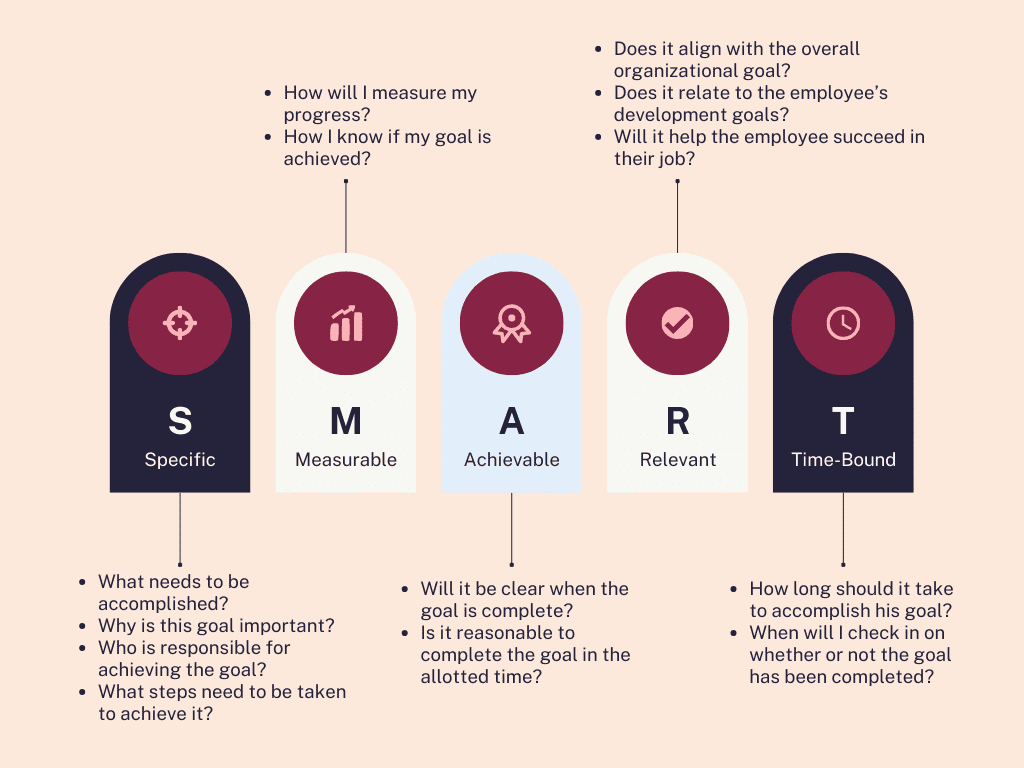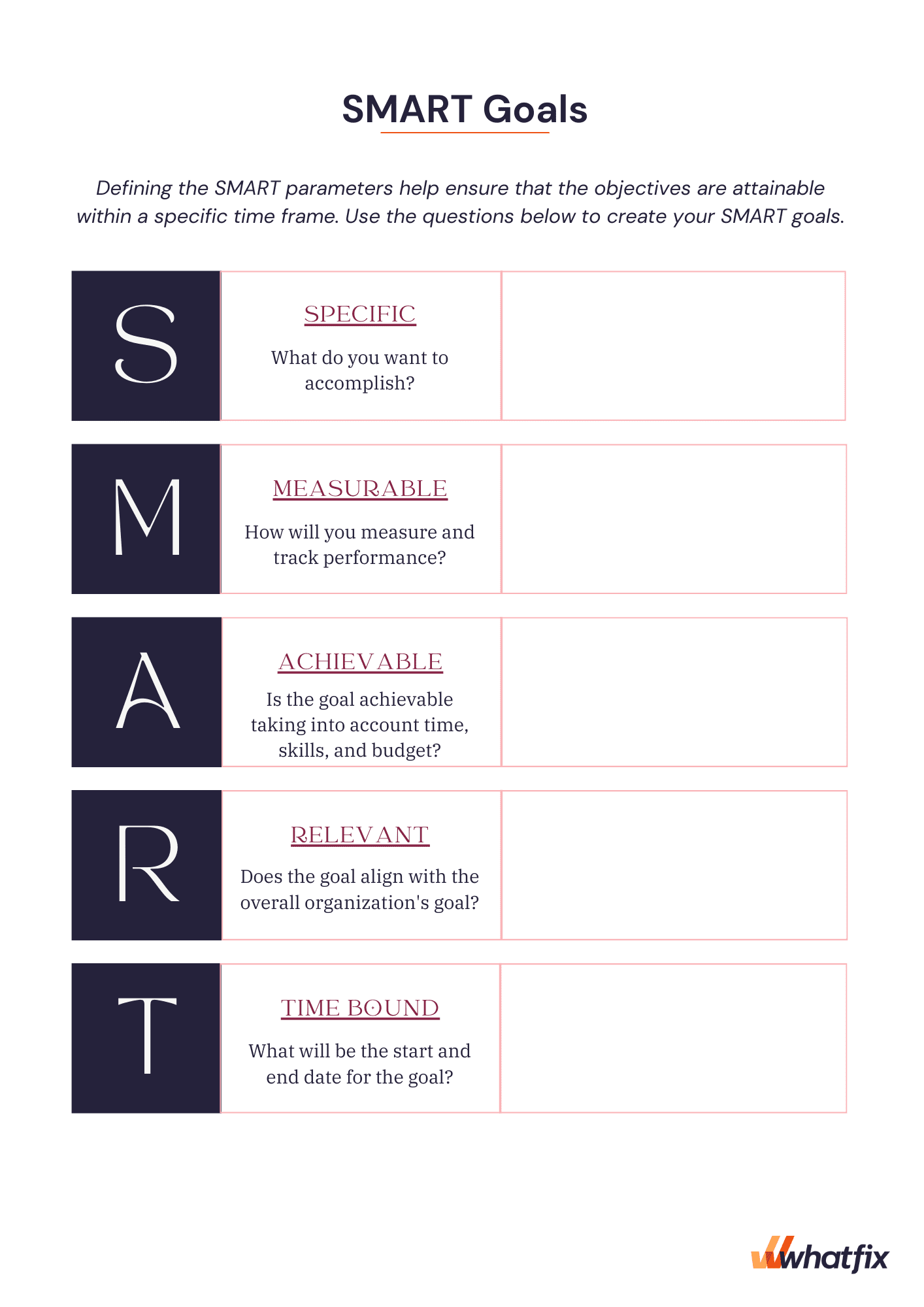How to Write SMART Goals in 5 Steps (+Template)
- Published:
- Modified: January 12, 2024


Setting goals is a critical performance-related exercise for organizations to challenge employees to build their skill sets, learn, innovate, and achieve business goals. They’re an essential part of the performance management process that sets defined goals that visualize and actualize success, driving employee performance.
However, creating practical goals requires work that ties individual performance to professional growth and team and company north-star goals. Managers must understand their employees’ strengths, weaknesses, and potential while crafting individual goals using a strategic lens.
The SMART goals framework is a goal-setting exercise that simplifies this process for L&D teams and team managers by creating goals based on five criteria areas, enabling employees to achieve personal goals and OKRs based on clearly defined objectives.
This article explains SMART goals, how to set achievable and measurable objectives for individuals and teams using the SMART goal strategy, and best practices for creating obtainable objectives and goals that drive professional development and drive business outcomes.
What Are SMART Goals?
SMART goals are carefully drafted objectives and targets set by team managers that employees work towards in a specific period. The SMART acronym stands for specific, measurable, achievable, relevant, and time-bound.
Defining these parameters enables teams with contextual, value-based, obtainable employee training objectives for a specific time frame. This approach eliminates generalities by assigning a clear timeline, obvious outcomes, and success metrics that enable employees to grow in their roles. Defining SMART goals makes it easier for managers to track the progress of employee growth while tying these goals to business outcomes.

5 Steps for Writing Effective SMART Goals
Writing SMART goals involves a systematic approach to ensure that objectives are well-defined, and outcomes are achievable and tied to organizational outcomes. Here are five steps for creating helpful SMART goals that enable employees.
1. Make your goal specific
The first step in creating SMART goals for your employees is to get specific with how you describe them. Think about this as the mission statement for your goal. This isn’t a complete list of how you’re going to meet a goal but helps provide clarity on its specific.
Managers should include the five ‘W’ question framework when setting and communicating goals to employees, which include:
- Who: Consider who needs to be involved to achieve the goal.
- What: Think about precisely what you are trying to accomplish.
- When: Set a time frame.
- Where: If there’s a location or relevant event, identify it here.
- Which: Determine any related obstacles or requirements.
- Why: What is the reason for the goal?
For example, instead of saying “increase sales,” a specific goal would be more practical when using the five “W” question framework to make it more specific, actionable, and outcome-driven.
- What: Closing more deals and increasing sales.
- When: By the end of the quarter.
- Where: In the United States and Canada markets.
- Which: B2B healthcare companies experiencing a specific challenge our product solves.
- Why: To grow revenue and grow out presence in the B2B healthcare sector.
2. They should be measurable
After setting your specific goal, it is time to evaluate how it will be measured. The M is a direct indicator of what success looks like for a particular goal. This step in the SMART goals process prompts you to set methods for measuring employee progress toward achieving their goals. Setting measurable goals for employees keeps them motivated, focused, and engaged.
A measurable goal addresses questions such as:
- How will I measure my progress?
- How do I know if my goal is achieved?
- Measurement methods can be quantitative (productivity results, money saved or earned, etc.) and qualitative (client testimonials, surveys, etc.).
Some typical data types and data collection methods include:
- Quality and accuracy rates
- Amounts produced
- Revenue generated
- Productivity rates
- Customer Satisfaction
Example: “Achieve a 15% increase in sales” or “Complete the training course with a score of at least 85%.”
3. Make sure the goal is achievable
Attainable SMART goals consider the employee’s ability to achieve them. The more realistic and achievable the goals, the more likely employees will keep working toward them.
Goals should be manageable, but should challenge your employee’s abilities while remaining obtainable. If a set of goals is unrealistic, employees lose motivation to find that extra push that would help them achieve more manageable goals because they feel defeated and frustrated.
To set achievable goals, think about:
- Is your objective something your team can reasonably accomplish?
- Is it reasonable to complete the goal in the allotted time?
- Do you have the tools and skills needed, if not, consider what it would take to attain them?
Example: If the average sales growth rate is around 10%, setting a goal for a 15% increase might be ambitious yet achievable.
4. Create relevant goals
SMART goals that are “relevant” related to your company’s overall business objectives and to a skill or professional development strategy that you want your employees to improve.
A relevant goal answers “yes” to questions such as:
- Does it align with the overall organizational goal?
- Does it relate to the employee’s development goals?
- Will it help the employee succeed in their job?
- Does this seem worthwhile?
- Is this the right time for this goal?
- Does this match the other responsibilities of the employee?
Example: If a company’s objective is to expand into new markets, a relevant personal goal could be “to develop a market entry strategy for two new countries in the upcoming quarter.”
5. Create a time-bound schedule
Time-bound refers to the timeline set for employees to work towards the goal, as well as how long it will take to meet the milestones and achieve the desired results.
Consider if your goal is short-term or long-term, and determine a timeline accordingly. Attaching attainable deadlines to SMART goals puts a healthy dose of pressure on your team to accomplish them and make significant progress in the long run. Additionally, a time-bound schedule prevents everyday tasks from taking priority over the employee’s longer-term goals.
Example: “Increase customer satisfaction ratings to 90% by the end of Q2.”
Free SMART Goals Template
To help you create effective, practical, outcome-driven goals for your team, we’ve created a free SMART goals template.

✓ Thank you, the template will be sent to your email
Examples of SMART Goals
To show how to put the SMART goals framework in action, we’ve included some detailed examples below.
1. Improve customer satisfaction
- Specific: Five members from the customer success team will work on increasing customer satisfaction (CSAT) and average review ratings by implementing client surveys.
- Measurable:
- Increase customer satisfaction score from 70% to 90%
- Each employee gets at least 1 positive customer review on G2.
- Attainable: Last quarter 3 customer reviews were published on G2.
- Relevant: Achieving customer satisfaction goal offers a whole host of benefits from improving customer retention and loyalty to creating customer advocates.
- Time-Bound: End of Q2.
SMART Goal Example: By the end of Q2, 5 employees will work on increasing the CSAT score from 70% to 90% and getting 5 positive customer reviews on G2 by implementing short surveys and resolving any negative issues they have with our service.
2. CRM training goals
A small sales company rolled out a new CRM platform for its sales reps to drive sales productivity and eliminate manual tasks. To get the maximum return on their investment, the company schedules instructor-led CRM training for sales reps to teach them how to use the platform to its full potential.
- Specific: A group of ten sales reps undergo instructor-led CRM training to learn how to create opportunities in CRM.
- Measurable: n hours saved per day by every sales rep post the use of CRM software.
- Achievable/Attainable/Agreed-upon: Discussing and re-assessing training with previous participants brought us to the conclusion of setting up an instructor-led training for a smaller group of people at a time.
- Relevant: CRM training will help our sales reps to use the tool to its full potential thereby giving us the maximum ROI.
- Time-bound: 30 days training session.
SMART Goal Example: A group of 10 sales reps undergo instructor-led CRM training for 30 days to learn how to create opportunities in CRM and start migrating from spreadsheets to the new CRM in order to use the software to its full potential and provide the maximum ROI.
3. Personal SMART goals for employees to improve performance
- Specific: Improving my skills to learn how to use Microsoft Excel efficiently and practice using it by implementing all important formulas.
- Measurable: By the time of my next review, I should be able to apply VLOOKUP, IF AND, and LEFT, MID, and RIGHT formulas, create charts, and create pivot tables in excel.
- Achievable: Improving my excel skills is instrumental in moving forward in my career and receiving a better performance review. I can enroll for an online course and set one hour aside every week to watch tutorials.
- Relevant: Working with excel is currently 25% of my job. As I move up in the company, I’ll need to spend 50% of my time managing data in excel.
- Time-Bound: In six months, I should be proficient in PowerPoint ensuring it only occupies 25% of my workload instead of the nearly 40% of the time it occupies now.
SMART Goal Example: Improving my excel skills in the next 6 months through online classes every week to become proficient and ensure that it only occupies 25% of my workload in the future.

Tips for Setting Effective SMART Goals
Here are a few tips to create practical SMART goals for your employees.
1. Break the goal down into subtasks
Significant goals can be overwhelming. Breaking your goals down into smaller, manageable subtasks makes them more achievable. This approach allows for a step-by-step progression towards the primary goal, making it less daunting and more structured. Each subtask should also adhere to the SMART criteria, providing clear milestones.
2. Track progress
Monitoring your progress is essential for staying on track and maintaining motivation. Regularly tracking your achievements against the measurable elements of your goals helps in identifying areas where you are excelling and areas that require more focus. It also provides an opportunity to celebrate small wins, which can boost morale and keep you motivated.
3. Use simple language
Goals must be straightforward and articulated. Using simple, unambiguous language helps ensure that the goal is easily understood and remembered. This clarity reduces the risk of misinterpretation and ensures that everyone involved has a shared understanding of what is to be achieved. A suggested format includes:
- a time frame
- a target audience
- an action verb to describe the outcome
- any other relevant information
4. Analyze your training conditions
When creating SMART goals for employee training programs, consider different parameters such as the availability of an instructor, budget, type of workforce, and prerequisites that affect the design and delivery of the program. Further, you must identify the challenges to your employee’s learning. Based on these factors, you can create achievable training objectives for your employees.
5. Find accountability buddies
Having someone to share your goals with can significantly increase your chances of success. An accountability buddy can provide motivation, support, and constructive feedback. This relationship creates a sense of commitment and can inspire you to stay on track, especially during challenging times.
6. Objectives and key results (OKRs)
For setting goals, the best-known goal management and execution framework followed by industry leaders is OKRs (Objectives and Key Results). The OKR framework ensures that the organization is aligned and executes with agility to achieve strategic and tactical goals. It enables managers to define goals collaboratively, cascade them to their teams, review progress, have conversations with the team, and finally reflect and reset goals by the end of the quarter. This method is particularly useful for aligning individual goals with the broader objectives of an organization.
Benefits of SMART Goal Setting
Here are a few benefits of setting SMART goals for your employees.
1. Provides clarity and focus
SMART goals clearly outline what is to be achieved, how it will be done, and by when, offering a clear roadmap. This clarity eliminates ambiguity, helping individuals and teams to focus their efforts and resources on specific objectives. When goals are well-defined, it’s easier to prioritize tasks and make informed decisions, leading to more effective and targeted actions.
2. Better employee performance & productivity
By setting specific, measurable, achievable, relevant, and time-bound goals, employees have a concrete understanding of what is expected of them. This structure lets them plan their work more efficiently and stay on track. When employees understand how their individual goals align with the organization’s objectives, they are more likely to take ownership of their tasks, leading to improved performance and increased productivity.
3. Motivates employees
SMART goals provide employees with clear targets to aim for. Achieving these goals, especially when challenging yet attainable, can be highly motivating. This motivation is further enhanced when progress is measurable, as employees can see the results of their efforts. The sense of accomplishment in meeting or exceeding their goals can be a powerful motivator and can lead to increased job satisfaction.
4. Employee development
SMART goal setting plays a crucial role in employee development. It encourages individuals to develop new skills, gain knowledge, and challenge themselves. Goals that are relevant to both the employee’s career aspirations and the organization’s needs can contribute to personal and professional growth. This development not only benefits the employee but also adds value to the organization by building a more skilled and competent workforce.

A digital adoption platform (DAP) empowers organizations to improve employee engagement and performance by enabling them with in-app guidance and contextual support, at the moment of need, for their contextual workflows on their mission-critical applications (think CRM, ERP, HCM, etc.)

DAPs streamline the learning process by providing real-time, in the flow of work learning. It also continuously enables employees to have performance support across all their workflows to maintain optimal efficiency and productivity. It takes a human approach to software investments.
Whatfix’s advanced analytics provide invaluable insights into how application end-user engage, use, and adopt software tools and related workflows. This data allows organizations to accurately measure the success of their application training initiatives, identify areas of end-user friction, support employees at key moments, and make data-driven decisions for continuous improvement.
By facilitating a more interactive, personalized, and measurable training, enablement, and support experience, DAPs such as Whatfix not only support the achievement of training goals, but contribute to the overall growth and digital transformation of your organization by empowering employees to use software with limited friction freely.
With a digital adoption platform like Whatfix, enable your employees with in-app guidance and contextual self-help IT support to accelerate the adoption of new software implementations, employee onboarding, change initiates, and more. Whatfix’s no-code editor enables IT teams with a no-code editor to create product tours, interactive walkthroughs, task lists, smart tips, pop-ups, self-help wikis, and more. Analyze and measure user engagement and software usage to identify friction points, measure digital adoption, and improve employee digital experiences.
To learn more about how Whatfix can help you fulfill your training goals, schedule a demo with our experts.
Thank you for subscribing!


